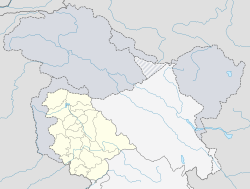Diskit Monastery
| Diskit Monastery Galdan Tashi Chuling Gompa |
|
|---|---|

Diskit Monastery
|
|
|
|
|
| Coordinates | 34°32′28″N 77°33′37″E / 34.54111°N 77.56028°E |
| Monastery information | |
| Location | Diskit, Nubra Valley, Ladakh, Jammu and Kashmir, India |
| Founded by | Changzem Tserab Zangpo |
| Founded | 14th century |
| Type | Tibetan Buddhist |
| Sect | Gelugpa |
| Dedicated to | Tsong Khapa |
| Number of monks | 100 |
| Architecture | Tibetan Architecture |
| Festivals | Desmochhey |
| Located in Diskit village, the headquarters of Nubra Valley | |
Diskit Monastery also known as Deskit Gompa or Diskit Gompa is the oldest and largest Buddhist monastery (gompa) in the Nubra Valley of Ladakh, northern India.
It belongs to the Gelugpa (Yellow Hat) sect of Tibetan Buddhism. It was founded by Changzem Tserab Zangpo, a disciple of Tsong Khapa, founder of Gelugpa, in the 14th century. It is a sub-gompa of the Thikse gompa.
Lachung Temple and Hundur Monastery are also located nearby, the latter is below the main road near a bridge.
The monastery has statue of Cho Rinpoche (Crowned Buddha) in the prayer hall, a huge drum and several images of fierce guardian deities. An elevated cupola of the moanstery depicts a fresco of the Tashilhunpo Monastery of Tibet.
The Monastery administration runs a school, with support from a Non-Government Organization (NGO) known as the "Tibet Support Group", which has computer facilities and teaches science subjects, in English, to Tibetan children of the region.
A popular festival known as Dosmoche or the "Festival of the Scapegoat" is held in the precincts of the monastery in February during the winter season, which is largely attended by people from villages of the Nubra Valley since the other regions in Leh are inaccessible during this period due to heavy snow fall.
The Diskit monastery was founded by Changzem Tserab Zangpo in the 14th century. The history of the Nubra Valley and the monastery could thus be traced from the 14th century onwards. Ladakh was then ruled by King Grags-pa-‘bum-lde (1400–1440) and his brother, who unsuccessfully attempted to usurp Nubra Valley, which was under a local ruler named Nyig-ma-grags-pa. The local ruler assisted a Gelugpa order advocate to build the monastery at Diskit and deify the idol of Tsong Khapa, the founder of the Gelugpa sect, in the monastery. During the rule of King Blogros-chog-idan (1440–1470) who had even controlled western Tibet, Panchen Lha-btsun - a resident of Nubra Valley by birth - studied in Tibet and later became a regent to the founder of Tashilhunpo Monastery and finally during his last stage of life returned to Nubra. His remains have been preserved in Charas. In 1500, Ladakh was ruled by Bkra-shis-rnam-rgyal, who fought the invader Mirza Haider of Central Asia, in Nubra and close to Leh, finally defeated the latter and thus bringing Nubra under Ladakh King’s rule. Even then, the local chieftains still yielded power in Diskit and Hundar. Shia Muslims started settling in Nubra after this war. Bkra-shis-rnam-rgyal’ son, Tshedbang-rnam-rgyal ruled Ladakh from 1530 and expanded his kingdom. At that time, Nubra people prevailed on him and preventing him from invading Hor in Xinjiang, as trade with Yarkand was considered crucial to Nubra. During the reign of Jams-dbang-rnam-rgyal, historical records indicate that a regular tribute payment was made by the Nubra people to the king. The King Bde-‘Idanrnam-rgyal (1620–45) successfully defeated Baltistan and the Mughals. Rgyal kings were very religious and built mani walls throughout their kingdom. Monks were specially engaged to recite hymns of Mani-tung chur in Nubra Valley and in other surrounding areas. In mid eighteenth century, Tshe-dbang-rnam-rgyal gave away the control of Diskit monastery to the Rinpoche of Thikse Monastery and this arrangement has been perpetuated to this day. Since then, Diskit is considered a sub-gompa of Thikse.
...
Wikipedia

